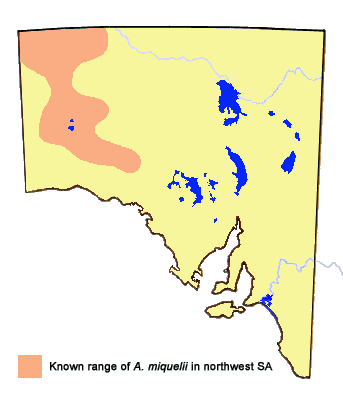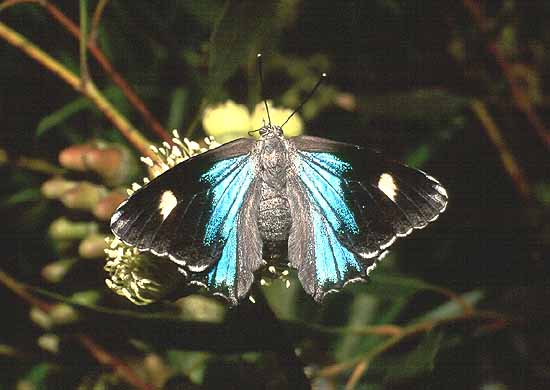-
Larval Food Host
-
Larvae feed on a wide variety of mistletoes. Those mistletoes found
in South Australia include Amyema maidenii (pale-leaf mistletoe),
A. miquelii (yellow box mistletoe), A. pendula (drooping mistletoe),
A. preissii (wire-leaf mistletoe), A. quandang (grey mistletoe)
and A. sanguinea (Loranthaceae). The hostplants for A. maidenii,
A. quandang and A. preissii are usually Acacia;
the hostplants for A. miquelii and A. pendula are usually Eucalyptus;
while A. sanguinea will parasitise both Eucalyptus and Melaleuca.
The preferred mistletoe seems to be A. miquelii. The larvae eat the flower
buds, flowers, leaves and soft stem parts of the mistletoe, but are particularly
fond of the flower buds.
-
Larval Attendant Ant
-
The larvae are attended by numerous large sugar-ants. Those species to be found
in South Australia include Camponotus (claripes group) and
Camponotus nigriceps. These ants prefer heavy loam soils to build their nests,
although the latter also build satellite nests in tree hollows above the ground.
The ants are nocturnal, large, only moderately ferocious (but without a sting),
although C. nigriceps can sometimes be aggressive. They have formed a
symbiotic relationship with the butterfly, whereby the ants provide protection
to the early stages of the butterfly from predators and parasitoids, and in
return the ants receive sugary secretions from the median dorsal secretionary
organ (honey gland or Newcomer's organ) situated at the posterior end of the
larvae. Adult ants are able to live off these secretions. Although never
aggessively pursued by the ants, the butterflies often become agitated in the
presence of the ants and will distance themselves from any unnecessary attention.
The ants essentially farm the larvae. They build separate chambers away from the
ant nest to house the larvae. The ant chambers or galleries are specially
constructed below ground around the base of the host tree by the attendant
ants for sheltering the early stages of this butterfly. There can be multiple
entrances, but they are always narrow and easily guarded by the large
Camponotus ants. These chambers can be quite extensive, circling the
base of the tree and extending along parts of the roots. The gallery space
between the tree and the ground is usually not much wider than the mature
larvae or pupae. Sometimes larvae will use hollowed out branches that are
lying on the ground next to the base of the host tree or will use hollows
within the host tree for use as a gallery. These ant chambers are usually
widely separate from the actual ants' nests (or ant brood), but sometimes
butterfly larvae will occur near the nest, but in this situation the ants
construct a separate chamber adjacent to the nest to house these larvae
which is separate from the ant brood.
The ants provide 24-hour protection, and when the larvae leave the chamber
at night to feed on the mistletoe, they are guarded non-stop until they
return to the chamber again before dawn.
Camponotus ants are harmless to humans, unless one is allergic to
formic acid. They should not be confused with the large stinging and dangerous
bull-ants, inch-ants or jumping ants.
The latter group have highly visible, very large and long jaws projecting
down from the head. In Camponotus the jaws are not highly visible.
-
Eggs
-
Large, hemispherical shape, strongly flattened top and bottom, the sides
are very finely reticulated in a hexagonal pattern, with each reticulation
intersection having a small raised blunt projection, the facets on the top
of the egg are smaller and these continue to the small-depressed micropylar
area at the apex of the egg. The basal half of the egg is greyish white,
the top half is mostly dark brown with a greyish white ring near the outer
dorsal edge, and the micropylar area is greyish white. The eggs are typical
for the species-group. The larva emerges from the egg at night by eating
out the dark brown coloured (central) dorsal area. (Parasitic wasps, one
per egg, emerge from the egg by eating out a smaller circular area in the
dorso-lateral region.)
The females prefer to lay where there is a strong residual smell of the
attendant ants, and also prefer hostplant which is already being utilised
by the early stages of the butterfly.
-
Larvae
-
The final instar grows about 30-32 mm long. They are mostly dull purplish
brown coloured, with pale yellow dorsal chevron markings and other indistinct
subdorsal markings, the chevrons on abdominal segment 6 are joined together
to form a yellow triangular mark, the lateral and anterior extremities of the
larvae are pale yellow, the prothoracic plate is dark grey with a yellow
longitudinal dividing line, the anal plate is dark brown and yellow with a
black longitudinal dividing line, and the spiracles are black. It is long
onisciform shaped, with a thoracic dorsal furrow, the lateral edges are
scalloped, the anterior and posterior areas are flattened, there are some
short peripheral bristly hairs, and there are some short dorsal bristles on
thoracic segment 3 and abdominal segments 1-6. The body is covered in dark
coloured, minute secondary setae, which consist of a short simple pointed
shaft set on a protuberant,angular and ridged base. The secondary setae
impart a scabrous appearance to the larvae. The posterior dorso-lateral
organs are well developed. The head is small, smooth, brown, hidden beneath
the body.
The larvae are gregarious, living in colonies of variable size, with up to 250
individuals being reported in the eastern states. However, numbers are usually
much less. During the day the larvae hide from predators by remaining usually
below the ground surface in the ant chambers, with the ants actively guarding
the entrances to the chambers. Colonies usually occur in the ant chambers,
but in wet areas larvae will also shelter under dry debris above ground or
beneath the bark of the mistletoe host tree.
Larvae feed only during the night, accompanied by large numbers of attendant
ants, and return to the ant chamber before dawn. Larvae usually feed on warm
nights. Presence of larvae on a hostplant is readily discernible by larval
eat marks on the mistletoe leaves, and they feed independently on the
mistletoe (not gregariously). Large colonies can sometimes defoliate the
mistletoe hostplant.
-
Pupae
-
Long cylindrical, rounded anteriorly and posteriorly, about 18-20 mm long,
dark brown to brownish black, with a few very short lateral hairs on the
abdomen. The surface of the pupa bears a very fine reticulated pattern
(similar to the eggs) that produces a scabrous appearance. The larvae are
strongly attached to the silked substrate by anal hooks and a central girdle,
usually to any non-earthen surface where they were resting when larvae,
such as below ground level within the ant chamber, under debris above ground
or beneath loose bark of the mistletoe host tree. The larvae pupate
gregariously together, and sometimes very large numbers of pupae can occur.
The butterflies usually emerge during the morning. The empty pupa shells are
not destroyed by the ants. The pupae are not known to audibly stridulate,
although interestingly like O. genoveva the prepupae can stridulate,
making a series of audible clicks, which are believed used as a means of
communicating with the attendant ants.
The pupa period varies from 12-24 days in Queensland depending on the time
of the year.
-
Flight Period in South Australia
-
The butterfly flies throughout the year in the northernmost parts of
its Australian range but tends to be more common at the end of the
wet season. In south and central Queensland it tends to fly during
the warm spring-summer-autumn months where at least two broods are
completed and the butterfly over-winters as larvae. In central WA
it is reported flying from late July to February.

-
Distribution
-
The butterfly occurs in tropical and subtropical latitude areas
wherever the habitat is suitable. It has been recorded in the
Alice Springs area immediately to the north of SA and there
is an unsubstantiated report of the butterfly occurring in the
arid portion of southeast Western Australia. It has yet to be
found in SA but suitable habitat and hostplants occur in the
Mann-Tomkinson-Musgrave-Everard Ranges group in the Far Northwest
Region of the state and it is possible that this butterfly will
one day be found in that area. If the WA report is correct
then the butterfly may also eventually be found in adjacent
western areas of SAin the Great Victoria Desert, although
recent efforts to find the butterfly in the Maralinga area have
been unsuccessful. The butterfly also occurs in Papua. It is
biologically unsuited to temperate areas.
In the Alice Springs area it has a tendency to fly in the rocky
range areas where the adults have access to pinnacle hill tops
and nearby larval hostplants. A. maidenii is a very common
mistletoe in SA but the butterfly is yet to be found, perhaps
suggesting the latter requires A. miquelii as a stimulant
presence before it will use A. maidenii.

-
Habitat
-
The butterfly prefers open moist woodland habitat that includes
hills or rocky outliers, but can tolerate semi-arid conditions.
The obligate attendant ants are widespread, with the recorded
types associating usually with heavy loam soils, although
C. nigriceps can also inhabit sandy soils through the
use of satellite nests in hollow branches above ground.
-
Conservation Status in South Australia
-
The butterfly is usually rare in its occurrence, but widely
distributed. It can sometimes be locally common where it
is well established in undisturbed colonies.
-
Threats
-
Threats in Central Australia are likely to be from drought,
fires and burrowing animals.
-
Conservation Strategy
-
None required.



